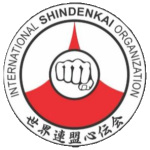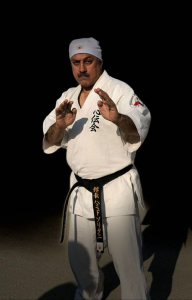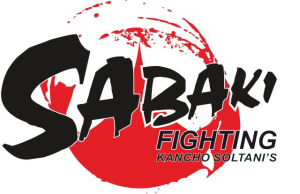
About ShindenKai Organization
Kancho Hamid Soltani
President Shinden Kai Karate

Kancho Hamid Soltani was brown in 1957 in Tehran. He started Karate in 1973 with Kan Zen Ryu and after that Kykoshin , and Judo too. He traveled to Japan for study in Karate in 1989. He had gone to some dojo. He practices Ashihara Karate with Kancho Ashihara. After joined to Enshin karate. he came back in 1992 to Iran, then he established Enshin Karate Organization. He informed and improves Enshin In Iran and in middle East. Kancho though need new movement for new generation. He found International Shinden Kai Oranization.
SHINDEN KAI, where the essence of bushido is embodied in Karate. The term SHINDEN KAI, derived from Japanese, signifies the recognition of those who came before us. Respecting their contributions is of utmost importance. Our mission is to follow in their footsteps while striving for continuous improvement.
The dominant red color in our logo represents our relentless pursuit of surpassing the limits of this metaphorical mountain. We embrace all available resources and the latest knowledge to ascend to greater heights. Karate has evolved significantly over time, and we acknowledge the transformation it has undergone.
The fist enclosed within the ring signifies the need for a cohesive and diverse community. It symbolizes the unity and shared purpose found both in Karate and in our lives. We firmly believe that if we cultivate the mindset of “I can,” we can accomplish anything, even when others may doubt us. We are committed to taking on challenges and defying expectations.
SHINDEN KAI represents not only a sport but a philosophy of life. It encompasses the values and principles that guide us in all aspects of our journey, extending beyond the boundaries of the dojo.
What is Sabaki?
Sabaki is a term used to describe a natural instinctive reaction or response to movements or actions, which varies from person to person based on their mental and physical conditions. It is a concept that is applied in everyday life as well as in many sports.

In the context of Shin Den Kai, a martial arts practice, specific exercises are designed to achieve optimal conditions and enhance sabaki performance. These exercises aim to develop speed and agility in responding to different actions or stimuli. By engaging in specialized sabaki exercises that simulate various situations, individuals are exposed to different conditions, which helps improve their ability to react effectively and efficiently.
In Shin Den Kai, the training methodology is structured to minimize direct face-to-face combat scenarios. Instead, utilizing the sabaki approach, practitioners are trained to position themselves outside the opponent’s line of attack, specifically in their blind spot, where they can offer the greatest resistance. By exploiting the opponent’s blind spot, practitioners can effectively execute various techniques while minimizing their vulnerability.
Sabaki challenge
The Sabaki challenge is a key strategy employed in Shinden Kai martial arts. It involves utilizing the principles of Sabaki in various positions and situations. The primary objective of the Sabaki challenge is to avoid direct face-to-face confrontation with the opponent.
Instead of engaging in a frontal attack, the practitioner aims to position themselves behind the opponent, in their blind spot, to execute effective strikes and counterattacks. By exploiting the opponent’s blind spot, the practitioner gains a tactical advantage and reduces the opponent’s ability to react or defend against their movements.
The Sabaki challenge encompasses full-contact Karate without protective padding or gloves, as well as full-contact Kickboxing with the use of gloves. It emphasizes realistic combat scenarios and encourages practitioners to engage in intense, unfettered exchanges. The absence of protective gear adds to the challenge and demands a high level of skill, control, and adaptability.
The Sabaki challenge serves as a test of a practitioner’s ability to apply the principles of Sabaki effectively in a real combat situation. It requires a combination of speed, agility, strategy, and precise execution of techniques to outmaneuver opponents and achieve victory in the martial arts arena.
Kata, Form
Kata, also known as forms, is a fundamental aspect of martial arts training. It is a structured sequence of movements and techniques performed in a specific pattern. Kata serves as a means to develop and improve various aspects of one’s martial arts practice, including the mind, spirit, technique, and speed.
When practicing kata, the practitioner imagines themselves engaged in combat with an imaginary opponent. There are two approaches to performing kata: classic and real. Classic kata follows traditional patterns and techniques, while real kata focuses on practical application and realistic fighting scenarios.
In Shinnden Kai, the kata are designed to be suitable for practitioners of all ages. For younger individuals, the emphasis may be on developing movement ability and speed, while adults focus on refining technique and execution. The classic kata in Shinnden Kai are similar to those found in other styles of karate. They are commonly used in tournaments to showcase skill and proficiency.
On the other hand, real kata in Shinnden Kai differ significantly in form and implementation. They are specifically designed as fighting kata for karate and kickboxing. Real kata aim to develop adaptable techniques and fighting stances that can be utilized in actual combat situations. Unlike the fixed techniques of classic kata, real kata allow for greater flexibility and spontaneity in response to varying circumstances.